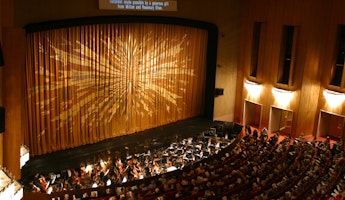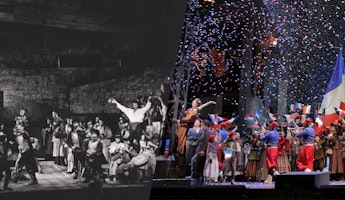Blog
October 18, 2023
From Page to Stage: "The Barber of Seville"
Figaro’s return to our stage is right around the corner with The Barber of Seville. Our favorite jack-of-all-trades has a long and fascinating history in opera, with appearances in The Marriage of Figaro and The Ghost of Versailles, among others. While we’re sure you’re familiar with Figaro and Gioachino Rossini’s iconic score, you may not know the fascinating history of how this opera came to be. To set the stage for The Barber of Seville, we’ll be looking at how Rossini came to form this comedic masterpiece.
Before Figaro would woo audiences with his immaculate arias, he would first appear in Pierre Beaumarchais’ 1773 play The Barber of Seville, or the Useless Precaution. Beaumarchais is a fascinating figure and it’s important to know that he did not hold the common beliefs of his time. He was an early French supporter of the American Revolution, lobbying the French and Spanish government to supply arms and financial assistance to America, as well as an early participant in (and then later a prisoner of) the French Revolution. He disagreed with the idea of aristocracy and his critiques are front and center in The Barber of Seville. Originally conceived as an opéra comique, a genre of French opera which mixes spoken word with music. The Barber of Seville follows the noble Count Almaviva who falls in love with a girl named Rosine (changed to Rosina in the opera), whose guardian Don Bartholo is planning to marry her himself. To gain access into Bartholo’s home and test Rosine’s love for him by disguising himself as a poor man, Count Almaviva hires the barber Figaro to aid his romantic endeavors.
While the play was written in 1773, it wouldn’t premiere until two years later due to a series of events which saw Beaumarchais imprisoned, victimized by a slander campaign, forced to give up his home, and even deprived of his rights as a citizen. It was only thanks to King Louis XVI, who was indebted to Beaumarchais for undercover work in England and Holland, that he was rehabilitated into French society and allowed to premiere The Barber of Seville. The play would bomb during its initial premiere, but after some rewrites its popularity exploded, spawning two sequels starring Figaro: The Marriage of Figaro and The Guilty Mother, the former being adapted to opera by Mozart further increasing the character’s popularity.
As a huge success, it was only natural that The Barber of Seville would be adapted into an opera. There would be three Barber operas that premiered before Rossini’s, though the most notable of these adaptations is Giovanni Paisiello’s in 1782 which at the time was seen as the definitive adaptation of the play. Paisiello had a very strong following which will become important as we reach Rossini’s premiere.
In late 1815, the impresario of the Teatro Argentina would commission the 24-year-old Rossini to create another adaptation of The Barber of Seville. Rossini would originally title the opera Almaviva; or, The Useless Precaution in deference to Paisiello. He collaborated with librettist Cesare Sterbini, whom he worked with previously for his opera Torvaldo e Dorliska, to create a faithful adaptation of Beaumarchais’ play. Rossini was an incredibly productive composer and would complete work on the opera in three weeks. However, one piece of music that was not included in that three-week writing session is the opera’s famous overture, which Rossini recycled from two of his previous operas Aureliano in Palmira and Elizabeth, Queen of England.
The opera had its premiere on February 20, 1816, at the Teatro Argentina in Rome. Just like Beaumarchais’ play, the opera struggled at first—and in fact had a disastrous premiere, including several onstage accidents. Couple this with the fact that Paisiello saw Rossini’s adaptation as an affront to his version, leading to fans of the senior composer jeering and hissing throughout the performance. Rossini was so embarrassed by the premiere that he decided to stay home for the opera’s second showing. Luckily, the second audience was enraptured, and after the opera they gathered outside of Rossini’s house to cheer.
The opera’s popularity would only increase from there, as it toured across Europe. It became the first opera sung in Italian in New York City when it premiered there in 1825. The opera would change its name from Almaviva to The Barber of Seville during the Bologna revival in 1816 (after Paisiello’s death).
After such a wild journey, Rossini’s The Barber of Seville has become a mainstay in the operatic repertoire and has outlived every single other adaptation of Beaumarchais’ play. Over two centuries later, audiences are just as eager to flock to performances, and if Rossini was still alive, we’d happily gather at his house again to cheer this enduring masterpiece. Make sure to catch Figaro and Count Almaviva’s antics when The Barber of Seville graces the LA Opera stage beginning on October 21.








/03-cosi/_dsc0996_pr.jpg?format=auto&fit=crop&w=345&h=200&auto=format)















